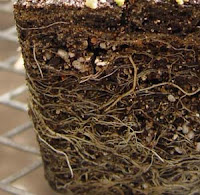 |
Photo by Jorge Vivanco
LabColoradoStateUniversity_edu |
An improved way to look at
soil!
CrabappleLandscapExperts picture the soil food web as a living,
breathing mass teeming with the roots of living plants, insects, worms,
invertebrates, amoeba, bacteria and fungi (both beneficial and pathogenic). All
of these living organisms need both moisture and oxygen to stay healthy, along
with nutrients and the proper acid/base environment.
There are many options for soil improvement. The LandscapExperts
view soil amendments as any material added to the native earth in order to
improve its ability to grow plants and create outstanding landscapes. Physical
properties such as soil structure, aeration, permeability and water
infiltration and drainage, as well as fertility properties such as soil acidity
or alkalinity, pH, cation exchange capacity and nutrient levels all play a
role.
Unlike mulch, amendments are thoroughly mixed into the soil.
1. organic soil conditioners
2. inorganic soil additives
3. mineral nutrient sources
4. biological inoculants and activators
5. plant stimulants, growth regulators, plant hormones
6. wetting agents or surfactants (primarily for potting mixes)
Following is a selected list of some of the materials that can be added to
metro-Atlanta’s Georgia red clay.
Organic soil conditioners
 |
Crabapple's Green Recycling Program
turns landscape waste into rich compost. |
Organic Compost
Aerated compost tea
Animal manure, aged and well-rotted
Manure tea
Bagged humus and compost
Mr Natural
Nature’s Helper
Mushroom compost
Worm compost
Worm tea
Seaweed
Humus
Ground pine bark
Coffee grounds
Blood meal
Bone meal
Alfalfa, Soybean or
Cottonseed meal – adds nitrogen, lowers pH
Wood ashes -
quick source of potassium, raises pH
Grass clippings
Wood chips
Straw
Sawdust
Peat moss
Inorganic soil additives or “place holders”
Coarse river sand - NOT the fine builders or
bricklayers sand bagged at the big box stores
Granite grit -
byproduct of Georgia's granite industry
Pea gravel - inert
Perlite - heat-expanded mica
Vermiculite - heat expanded mica that holds water and
Shredded tire chunks
Mineral nutrient sources
 |
| Adding lime to surface of lawn. |
Lime - Dolomitic
lime is magnesium calcium carbonate
Gypsum – calcium
sulfate
Rock Phosphate
or Triple superphosphate - slow release does not pollute riversheds
Greensand – iron potassium silicate aka glauconite
Sulfur - acidifies
the soil
Epsom salts – magnesium sulfate
Aluminum Sulfate -
acidifies the soil, as for Japanese Iris or BLUE Hydrangeas
Biological inoculants and activators
Beneficial bacteria, friendly fungi to inoculate roots and mycorrhizal
associations
benefiting plants through increased nutrient uptake
Agverra SRT, Dr. Earth Super Active Biological Inoculant,
Soil Smart
Plant stimulants, transplant solutions, growth regulators
Superthrive rooting hormone, vitamin and plant hormone (1
drop per gallon formula)
Rootone rooting hormone
Wetting agents and surfactants
Terra-Sorb Hydro Gel - a "water grabber" commonly mixed into potting mixes to allow water absorption by
hydrophobic (water-hating) peat moss
The LandscapExperts select from among this lengthy list to provide your landscape soils with amendments to bring them to optimum condition.
Digging Deeper

















